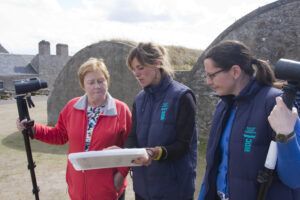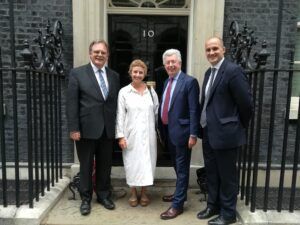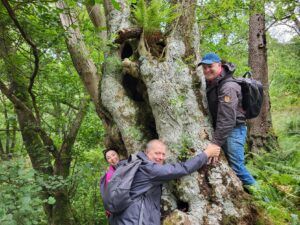As Scottish Environment LINK’s Nature Champions initiative celebrates its tenth year, Nature Champions Coordinator, Andy Marks, highlights its value in galvanising political support for Scotland’s threatened and iconic species and habitats.
It is incredibly heartening to catch Members of the Scottish Parliament discussing which species and habitats they are championing as part of the Nature Champions initiative. The light-hearted pride with which some MSPs announce the name of their species or habitat is very encouraging to hear, particularly when so few species and habitats have historically been recognised and valued in public life.
There were many exchanges of this kind at last week’s formal launch of the public exhibition, A Voice for Nature: 10 Years of Nature Champions. The free exhibition, which is located outside the front of the Scottish Parliament until 22nd September, highlights how past and present MSPs have been working as Nature Champions over the past decade to be a voice for nature in the Scottish Parliament.
For those unfamiliar with the initiative, Nature Champions works on a simple premise: each MSP champions a threatened or iconic Scottish species or habitat for the duration of that Parliamentary session. By becoming a Nature Champion, MSPs from all political parties work alongside Scottish Environment LINK members to champion their chosen species or habitats. Scottish Environment LINK members support MSPs by raising awareness of the threats the different species and habitats are facing, as well as the political action needed to halt or reverse these declines.

Former MSP and Nature Champion for the Harbour Porpoise, Maureen Watt, pictured in 2018 at Whale and Dolphin Conservation’s Scottish Dolphin Centre at Spey Bay, Moray Firth. © Whale and Dolphin Conservation
On a more individual level, part of the beauty and importance of the initiative is also its ability to foster unanticipated connections between our elected representatives and our natural environment. From attending site visits to see their species or habitats in situ, to meeting passionate members of their constituencies, the initiative helps to emphasise the value of Scotland’s species and habitats at a time of unprecedented decline in global biodiversity.
As the 2019 IPBES Global Assessment for Biodiversity and Ecosystem Services report has described, the causes of biodiversity decline can be understood as falling into two categories: those so-called ‘direct’ drivers of global biodiversity loss including climate change, pollution, invasive non-native species, direct exploitation of organisms and changing use of lands and sea, and those ‘indirect’ drivers of biodiversity loss, namely, a cultural lack of value and recognition of the importance of nature, and a societal disconnect with nature. In Scotland, as with the rest of the world, these indirect drivers of biodiversity loss need to be addressed to prevent further biodiversity loss. In other words, to halt the ongoing decline of Scotland’s biodiversity (Scotland ranks in the lowest 15% of countries in terms of its biodiversity intactness) we must transform those values and behaviours that have led us here, and not just the immediate symptoms of an unsustainable culture.
In this vein, the Nature Champions initiative not only brings the direct drivers of biodiversity loss in Scotland to the attention of MSPs, particularly those that immediately affect their chosen species or habitat, but it also helps to transform the perceptions of MSPs towards different species and habitats, including those so-called ‘uncharismatic’ species or habitats: our ecologically vital leeches, lichens, molluscs and bogs, for example. Through learning more about their species or habitats, seeing them in person and meeting the people who rely upon and care for them, Nature Champions develop on-the-ground (or under-the-water!) relationships with Scotland’s wildlife. These connections are of the upmost importance if we are to successfully tackle the indirect drivers of biodiversity loss and ‘mainstream biodiversity into all areas of policy’, as recommended by the Scottish Parliament’s 2022 SPICe Spotlight report, Governing Nature – Halting Biodiversity Loss.

Former MSP and Nature Champion for the Curlew, Lewis Macdonald, pictured at the Curlew Summit at 10 Downing Street in July 2019. Alongside Mr Macdonald are fellow UK Curlew Species Champions, Mark Isherwood AM and Jake Berry MP. © Sarah Sanders / RSBP
The initiative has been a huge success over the past ten years, with over 175 different MSPs becoming Nature Champions, and similar programmes taking off in Wales, Northern Ireland and England, as well as within schools, community groups and local authorities.
Since 2013, Scotland’s Nature Champions alone have lodged over 200 Parliamentary Motions and Questions in support of their species or habitats and discussed their roles in 17 Parliamentary Debates on the natural environment. They have also taken part in hundreds of site visits and constituency activities, many of which are featured in A Voice for Nature at the Scottish Parliament. These visits have included boat trips to Scotland’s rainforest to see mature oak woodlands, snorkeling with local residents in sea lochs to discover important flame shell beds, or even night walks around Holyrood Park to search for native bat species. Each of these encounters between a Nature Champion and their species or habitat has moved us a step closer towards meaningfully considering their interests in policymaking.

Nature Champions, Monica Lennon MSP (Scottish Labour), Graham Simpson MSP (Scottish Conservatives) and Mark Ruskell MSP (Scottish Greens), join hands around an ancient ash tree at RSPB Inversnaid Nature Reserve in August 2023. © Scottish Environment LINK
As we look to the future of Nature Champions, we hope that even more MSPs will take up the opportunity to become Nature Champions. At present, iconic and threatened species and habitats including the Black Grouse, Coastal Sand Dunes and Common Glow-worm, to name a few, remain without representation in the Scottish Parliament. With continued political buy-in, we hope to support Members of the Scottish Parliament to learn more about the extraordinary species and habitats that we live alongside, thereby encouraging the necessary revaluing of our natural environment as a key political priority for our future.
A Voice for Nature will be located outside the main entrance of the Scottish Parliament, Edinburgh, until Friday 22nd September. You can find out more about the exhibition, as well as all the audio clips and transcripts featured in the exhibition, on our website.
